Hair System¶
Overview¶
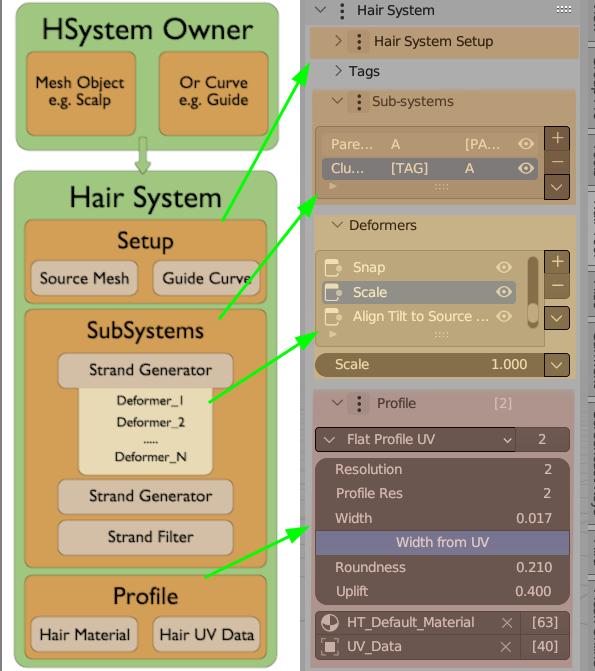
Hair System assists you in creating procedural hair strands in a non-destructive way, utilizing Blender's Geometry Nodes technology.
Hair System is made from:
- A setup section to assign a guide curve and source mesh
- Hair sub-systems with generators and Deformers to create and modify strands
- A hair profile to add geometry, UVs, and materials to strands
Hair Sub-Systems in stack can communicate together with usage of Tags - this help to describe which Hair System is affecting which strands.
Hair System is located in Right Sidebar → Hair Tool Tab → Hair System Panel. Click [+] to add Hair System to selected mesh or curve object.
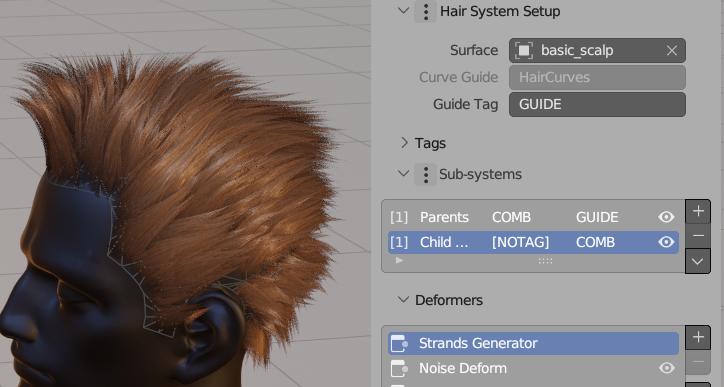 On image above we have Two Hair Systems named:
On image above we have Two Hair Systems named: Parent, Child. You can see Child system is made from: Strand Generator, Noise, Clump, Set Radius etc. deformers. Whole system is guided by: HairCurve guide - second input at very top
Strands generated with Hair Systems are then passed to hair profile generation system, which convert these strands to hair-cards.
One Minute Hair Setup¶
Below I show you demo of how to setup game ready hair in 1 minute:
Full setup - starting from scalp mesh, and ending with mesh haircards ready for export
Description of steps:
- Select scalp mesh, and go to Draw Hair Panel > Enable Draw Hair
- Hold D key, and draw guide curves with LMB (default Hair Material and UVs will be automatically assigned to them)
- You may need to adjust flat profile width (it was ok above, but it depends on size of your mesh)
- Add Hair System with Strand Generator option, and go to Hair System Panel.
- Hair System panel > Deformers > Strand Generator > Bumping up strands density to 22222 (value depends on size of your object)
- Adding Deformers:
- Radius Set - it will taper the haircards
- Noise - it will break the even look of hair
- Align Tilt - it will force hair cards to face scalp surface
- Ctrl+Shift+H > Convert Hair to Mesh (or you can use Finalize, to create mesh copy of HSystem)
That is it, you can now export generated mesh to Game. If you want, you can restore curve hair object with Ctrl+Shift+H > 'Restore Hair Object' - and continue working on it.
Two Minute Hair Setup¶
In video below we make hairstyle with split.
Full setup - starting from scalp mesh, and ending with mesh haircards ready for export
Above we used option of selecting strands by mesh island > see Strand Selection section.
Transfer Hair System¶
Hair System can be assigned to Mesh or Curve Hair object, depending on which object is selected when you add Hair System. If you want to change Hair System 'owner' you can use Transfer Hair System operator.
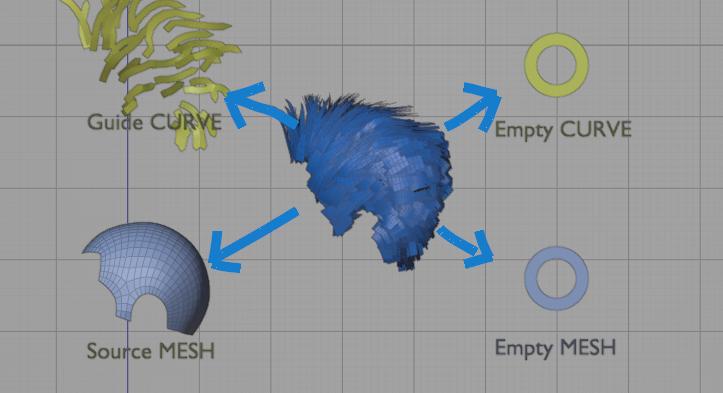
Hair System that generates hair-cards (in center above) can be assigned to:
Source/Base Mesh mesh from which strands are spawned from (often scalp mesh)
Empty Mesh helper, without geometry, usually linked with Source Mesh and Guide Curve
Guide Curve curve object that guides strands
Empty Curve helper, without geometry, (usually linked with Source Mesh and Guide Curve)
Hair system transfer possibilities:
| Current Owner | Transfer To | Result |
|---|---|---|
| Guide Curve | Base Mesh | Hair System will be moved to Base Mesh Surface (usually scalp) |
| Guide Curve | Empty Mesh | Hair System will be moved to new, empty mesh object |
| Empty Curve | Base Mesh | Hair System will be moved to Base Mesh Surface (usually scalp) |
| Base Mesh | Guide Curve | Hair System will be moved to Guide Curve |
| Base Mesh | Empty Curve | Hair System will be moved to Empty Curve Hair object |
| Base Mesh | Empty Mesh | Hair System will be moved to Empty Mesh object |
| Empty Mesh | Guide Curve | Hair System will be moved to Guide Curve |
| Empty Mesh | Base Mesh | Hair System will be moved to Base Mesh |
Visually, there should not be any noticeable difference. However, the owner of the Hair System will change
User cases when you want to use Transfer Hair System:
- if you want to 'Bake' curves generated by Hair System to curve, but it is assigned to Mesh (meshes cannot receive curves geometry). In that case you can transfer Hair System to Empty Curve, and then bake it to it
- if hair interpolation is broken (e.g. stops working after you select and try to sculpt Guide Curve. See note in Hair Interpolation section
General Operations¶
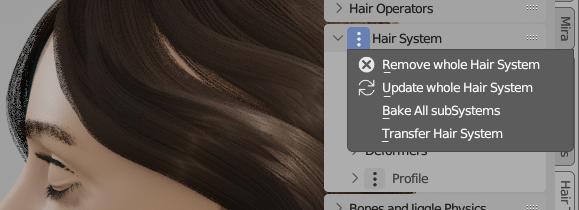
- Remove whole Hair System - removes all Hair Systems, Setup and Profile modifiers from object
- Update Whole Hair System - updates Setup, Profile, Hair SubSystems (without deformers) nodes. All nodes are recreated from scratch, it is destructive operation and may break your Hair setup!
- Bake All SubSystems - bake curves generated by All Hair sub-Systems into 'real' curves geometry. This works only on hair curve type of objects (try: Ctr+Shift+H > Transfer Hair System: to Empty Curve, or to Guide Curve)
- Transfer Hair System - explained here
Sub-Systems Types¶
After adding a Hair Sub-System, you'll see the first slot in the deformer stack is added automatically. This is determined by the selected hair sub-system type.
Strands Generator¶
It will generate strands, from Base Mesh surface, with parameters like: resolution, density, length, interpolation (Parent Child relation must be set) etc. These strands are affected by all subsequent deformers in current system stack
Set parent Tags and enable interplation option, so that generated strands will follow these Tagged strands. See Child Parent Setup
Align to Surface Normal - option changes how the interplation works. Do not confuse with Align Tilt To Source Surface
Strands Filter¶
The tool will enable you to make adjustments to existing hair strands. It does not matter if these strands are 'real' - e.g. generated with Hair Drawing, or generated procedurally by preceding Hair subSystem. It offers the option to affect only some of the strands, by filtering them with TAGs.
Imagine you want to modify two Hair Systems, by adding Set Radius or Align Tilt. Instead of applying these deformers to each individual Hair subSystem, you can utilize the Filter System to affect all strands simultaneously.
Demo of applying 'Scale' deformer to strands generated with Right Tag
Note: If no filter tag is specified, then all strands will be affected
Strands From Grid Surface¶
This is special type of Generator, that will generate strands from Grid Surface (chessboard like mesh, made of quads with grid topology). Root of strands will be placed:
- on edge loop marked as Sharp (Ctrl+E -> Mark Sharp)
- or on crease edge (Shift+E -> Crease Edge).
These strands are affected by all subsequent deformers in current system stack
In video above - top, boundary edge loop was marked as sharp
Note: Notice how guide grid, in video above, has uneven topology - getting dense to the right. This is important when adjusting 'Uniform Spacing' option
Note: To mask-out placement of roots, just plugin in vertex group mask into 'Placement Mask' input
Child - Parent setup¶
Linking two Hair SubSystems, with Child-Parent relation, enables capabilities such as: interpolation, clumping, curls, braids, twist and others.
Use Tags to link two Hair SubSystems, establishing a parent-child relationship.
In the video above, I show how to make the red strands (called "ParentSys") the parent (guide) for the yellow strands (named "Child"). You can use any tag name you want. In this example, I used "RED".
Note: Parent Hair System has to be placed above Child System in the stack, or else Child strands won't 'see' the Parent strands
Hair Interpolation¶
To enable hair interpolation, current Hair System has to have parent - see above.
After that Toggle Interpolation button will be accessible (enabled by default) in first deformer - Strands Generator properties
Note: In some cases interpolation may behave erratically (e.g interpolation breaks when you select Guide Curve). The most likely cause is - cyclic dependency:
- Guide curve depends on your base mesh (usually scalp),
- Base Mesh (with Hair System attached) depends on guide curve (through enabled interpolation to Parent - Guide Curve).
To fix it and break the cyclic dependency use Transfer Hair System and move Hair System to either Empty Mesh or Guide Curve.
Since Hair Tool 3.0 and later versions, strands interpolation operates within areas surrounded by mesh islands - meaning, if you want to make hairstyle with split:
- split scalp mesh in two, without separating to new object, (e.g. select edge loop, that divides the scalp in half - and press 'V' to rip it). Now child strands will not cross this edge.
In video above I have cut mesh in 4 parts (visualised with 4 colors). Strands won't cross islands boundaries
Note: If you want to make hairstyle with split, you can use Select By Island to select guide strands from specific island
Note: instead of splitting the edges physically, you can use the Edges split modifier
Hair sub-System menu¶
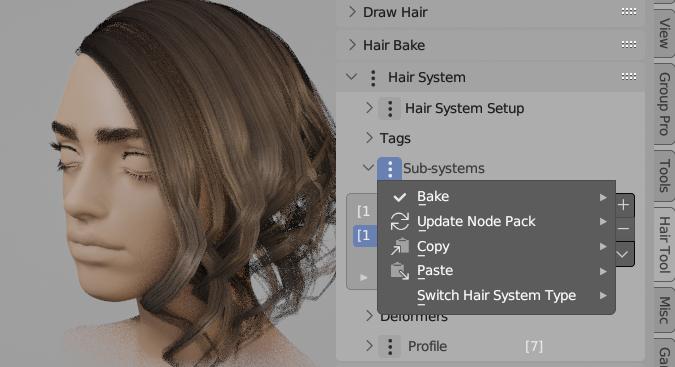
You can copy settings from any hair system, and paste to target using entries above.
Bake¶
Procedurally generated strands cannot be groomed. First convert them into 'real' geometry with 'Bake' operator. This will bake: active (and preceding) Hair sub-Systems or All Hair sub-systems into 'real' curve geometry, that can then be groomed using Blender 'Curve Sculpt' mode.
Note: Baking works only if Hair System is attached to hair curve type of objects! If not the use: Ctr+Shift+H > Transfer Hair System > to Empty Curve or to Guide Curve)
Curves in video cannot be groomed, since they are generated procedurally. After baking, you can groom them without issues
Update Node Pack¶
Update selected Hair Components (geometry node setup) to its latest version, for example after updating add-on
Copy/Paste Hair System¶
Copy Hair System settings from: Active Hair sub-System or All sub-Systems
Paste Hair System settings to: Active Hair sub-System or to All sub-Systems
Copying All SubSystems (and profile settings) from one object to another. Receiving object has to have at least one Hair subSystem attached. Also make sure both objects share same vertex groups, similar sharp (or crease) edges - if you copy Curves From Grid type of setup
Switch Hair System Type¶
Switch Hair System Type - for example from Strands Generator to Strands Filter.
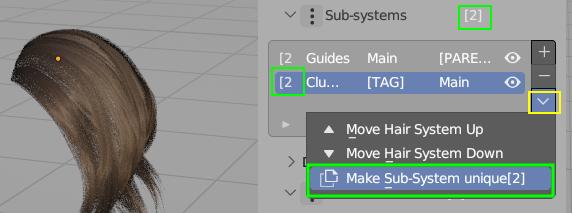 Pasting Hair System settings (or instancing object that uses Hair System), will create linked copy. This means that change performed on new copy, will affect original Hair subSystem too. Number of Hair System users is displayed next to Hair Tag (green box in image above)
Pasting Hair System settings (or instancing object that uses Hair System), will create linked copy. This means that change performed on new copy, will affect original Hair subSystem too. Number of Hair System users is displayed next to Hair Tag (green box in image above)
Note: You can unlink Hair System, by clicking on 'users number' (see green box above)
Tags¶
Think of Tags as labels we apply to the strands in a Hair System. They enable us to establish child-parent relations or manipulate specific strands with strands filter. Why won't we use system name for that functionality? The reason is, that you can assign multiple tags to same strand e.g.:
- Hair System A strands Tags:
LONGandCURLY. - Hair System B strands Tags:
LONG
Now you can modify strands tagged with LONG label - using Strands Filter, without having to create same deformers on Hair System A then B twice.
Tags can be also assigned to subset of strands from within Hair System with Assign Tag deformer.
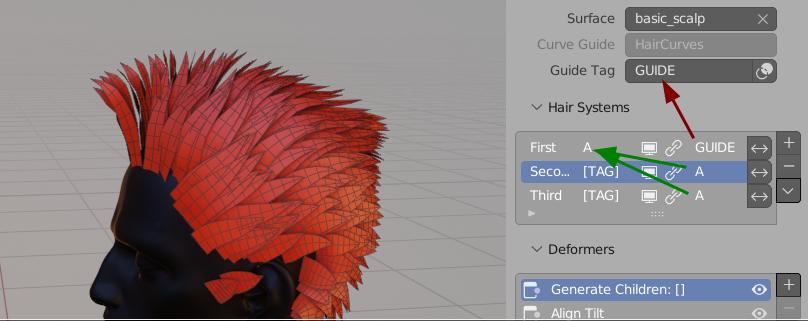 In image above we tagged 'First' Hair System
In image above we tagged 'First' Hair System A with label. 'Second' and 'Third' system are linked to it - which allows us to use e.g. interpolation on them. Note: Guide curves received GUIDE tag automatically
Tag can be assigned in few ways:
- by typing it in next to system name see
Atag in image above. If system has no tag assigned then[TAG]label is shown - by using Assign Tag deformer
- you can also assign tags to Hair System guide object (new Curve Hair) using Tags Panel. See Below
Tags Panel¶
In video above we create Tag A, then assign selected curves to tag A using Assign button
Note: Assigning Tags only works on new Hair Curves. To be able to select individual curves, like in video above, you have to use Hair Modeling mode. For now only selection works from all the available Modeling Tools
Hair Deformers¶
Deformers gives you ability change chair look - add noise to hair, make them curl, snap to surface etc. They are stacked one on top of each other in similar way than Blender modifiers. They can be reordered. Some deformers (e.g. clump, twist, braids) will only work, if Hair System, to which deformers belong to is Set as Child
Braids (Child)¶
Clump child strands to Guide/Parent strands (FIRST tag) in shape of Braids. Set Hair System as child first
Color Set (System)¶
It will alow your to colorize haircards generated inside current hair system (added mostly for debugging hair sub-systems setups)
Clumps (Child)¶
Clumps child strands toward parent strands. Set Hair System as child first
Curls¶
Clump child strands to Guide/Parent strands (FIRST tag) in shape of Curls. Can be used with Hair System as child first
Generators¶
Duplicate Strands¶
Simple duplication of exisitng strands
Braid Generator¶
Each strand will be duplicated 2 times (3 strands with original one), and braided together. Works best with 'Circular' Profile
The Idea in above video is:
- Take single strand, and convert it to 3 braided ones with 'Braid Generator'
- Duplicate each sub-strand few times with Duplicate Strands deformer
- Add some randomization with Noise deformer and UV Region Set deformer
This should make it more volumetric looking, since braid will be made from multiple textured haircards, rather than single one.
Instance on Strand¶
Instance any mesh on hair Strands (can be used to eg. add tie and tail on the end of braid) - since HTool 2.44
Mirror¶
Mirror hair, with optional option of bisect (remove one half of hair first, then mirror the remaining part)
Move in/out of Surface¶
Embed Roots¶
Helps to push hair roots into surface. Best to used before Align Tilt deformer, since it can lead to haircard twisting
Push Out¶
Push hair outside surface. Useful when wanting to push out layer of hair or to prevent hair clipping through character geometry
Attach To Surface¶
Attach hair to surface. Useful when wanting to 'glue' hair to character geometry (scalp)
Move to Border¶
In the video above, a source mesh is created using two half-sphere meshes. We use the "Move to Border" deformer to move the strands to the edge of this mesh. Then, we apply the 'Track To Mesh' deformer, to clump tips of strands together
Snap¶
Snap hair to source surface (could be used for wet hair effect)
Lengthen¶
Lenghtens hair strands. Unlike simple scale - it will make hair extend from the tips
Noise¶
Add noise distortion to strands
Radius Set¶
Set Radius - for hair tapering, strand width randomization, etc. Can also guide Curls amplitude or Braid size - for child Hair Systems
Roll Strands¶
Basically the same as blender build-in Roll
Scale¶
Scale hair up or down. With trim deformer we can reduce length of hair, but Scale deformer helps to make them longer.
Simplify Strands¶
Resamples strands - assigning lower points count to shorter strands
Slide Points¶
Give more resolution to hair root or tips (depending on 'Influence Range'), by 'sliding' points along the curves
Smooth Strands¶
Smooth out the strands
Tag¶
Assign Tag¶
Here we assign R tag to right side of head (masking it with vertex group). Then in 'Scale' Hair System that is set to Strands Filter we resize these tagged strands with Scale deformer
Note: Assigning any tag e.g. X will create negative tag 'X, for example if we create tag
RIGHTwith some strands, then tag'RIGHTwill contain opposite set of strands.
Delete Strands¶
Simple delete strands operation based on their Tag. In video above I removed strands tagged as R then GUIDE strands (bit hard too see, since they are covered by other strands)
Tilt¶
Add Tilt¶
Add tilt to hair strands. If 'Flip Probability' is 0.5 - then half strands will be rotated clockwise and half counter clockwise
Align Tilt¶
Aligns tilt to hair source surface (hair normal will point outside of surface)
Align Tilt to Parent¶
Aligns tilt to Parent (Guide) strands. Hair card backfaces are shown in blue. Great for Dragon Ball hairstyle :)
Align Tilt to Target¶
Aligns tilt to target surface (hair normal will point outside of target surface)
Align Tilt to Mesh Border¶
Align strands tilt to border of source surface (usually scalp). Backfaces are shown in blue
Force Align if checked, it will align curve and force curve normal to point outside border edge. If unchecked, tilt will be aligned to border, but curve normal will point with the 'flow' - see video above.
Track To:¶
Track to Mesh¶
Track to Mesh - Strands from closes mesh island will follow tracked mesh object. Use Bind button to prevets hair tips from 'sliding' on mesh surface
Note: Closest affected island is determined by Tracked object origin. Move it to change which island will be affected. After finding desired island, you can move tracked object in edit mode, so that affected strands won't change.
Note: If you want to 'Freeze' tracked points, use 'Bind Tracked Mesh' button. Now strands will follow point at which they were bound, rather than sliding around mesh surface.
Track to Curve¶
Track to Curve - Strands from closes mesh island will follow tracked curve object. Use Bind button to prevets hair tips from 'sliding' on tracked surface surface
Note: Closest affected island is determined by Tracked object origin. Move it to change which island will be affected. After finding desired island, you can move tracked object in edit mode, so that affected strands won't change.
Note: If you want to 'Freeze' tracked points, use 'Bind Tracked Curve' button (this will convert 'old' curve to 'new' type). Now strands will follow point at which they were bound, rather than sliding around curve surface.
Note: Curve Shape Keys are great addition to Track To Curve deformer.
Trim¶
It will shorten strands roots and/or tips. Best to use with randomization mask
Twist¶
Twist effect requires to set Hair System to be set as child. For best effect is is good idea to place it after Clump deformer
UV Region Set¶
Hair Profile holds UV data (like UV boxes dimensions), but it does not tell which strand will receive which UV region. This is where 'UV Region Set' deformer comes in. It is created automatically when Assigning UV Regions. Add multiple 'UV Region Set' deformers, if you want to achieve layered UVs.
You can use multiple 'Set UV Regions' Deformers, and stack them on top of each other (think of them as layers). In video above, I used 2nd Region (green) as base layer, then added 0th Region (purple) on top - masked by vertex group
- You can also use Set UV Region, and it will automatically create new 'UV Region Set' Deformer (or use active one if selected in Deformer Stack)
- If not UVs were assigned to current Hair System object, then running 'Set UV Regions' operator will add default UVs (with single UV box/region)
Input Masks¶
You can mask most of the hair deformers inputs with various kind of effects. Multiple masks can be added.
Note: The order matters: first top mask is evaluated then next to the bottom
To add mask click drop down menu icon on right and pick mask type
Border Edge Distance¶
Border Edge Distance: mask an effect based on strands distance to border of source mesh. Above we used Align Tilt to Mesh Border deformer, to align tilt only on strands that are closest to mesh border. It has invert option too.
Curve Attribute¶
Curve Attribute: Use Curve attribute to mask hair effect. This is intended to be used with Edit Curve Attribute feature in HTool
Vertex Group/Texture¶
Vertex Group/Texture: Use vertex group or texture for input masking
Offset/Gain¶
Mask Offset Gain: Not useful by itself, but placed after another mask, it can increase the mask contrast (gain) or brightness (offset)
Invert¶
Invert: Not useful by itself, but placed after another mask, it will invert the previous mask effect
Randomize¶
Randomize: Outputs random value for each strand.
Random value will be picked from within [x-RandRange; x+RandRange] bounds, where x - is any input value - e.g. from vertex group mask
You can disable lower/upper bound using </> buttons, thus limiting Random value range.
- Rand Range - 0 - no randomization; 1 - maximum randomization
- Variance < 0.5 outputs mostly smaller values, from within given range,
- Variance == 0.5 all random values are drawn uniformly, from within given range,
- Variance < 0.5 outputs mostly bigger values, from within given range,
- Use Parent IDs - if enabled each child strand will inherit random value from its closest parent.
Length Mask¶
- Assigns Min value to the shortest strands,
- Assigns Max value to the longest strands.
- Swapping Min and Max values will invert the effect
Procedural Mask¶
Procedural Mask: Use procedural noise texture to randomize hair look. No need for UVs
- Min, Max - bring these values closer together to get sharper noise transition,
- Scale - the bigger scale the more detailed the texture will be,
- Distort - distorts the noise,
- Offset - offset the noise sampling position
Influence Range¶
Special mask that allows to modulate influence of deformer over strand length (e.g. taper only tip of strand). 0 - no effect, 1 - maximum effect
Types of Influence range masks:
- Constant - the effect is uniform along the whole strand length
- Simple - gradually changes the influence from 0 to 100%. Influence can be flipped using invert button
- Quadratic - gives more detailed control: modulate effect independently at strand beginning, center and end
- Profile Curve - most detailed control using profile curve
Updating¶
After updating Hair Tool add-on, you may need to update your Hair Setup:
- There is option to update Individual Hair System elements (Deformers, Masks, Profiles etc.) - located in Deformers dropdown menu
- Setup and Profile node (green and blue box on image below)
- Update Whole Hair System located in General Menu - this will update all nodes, in all Hair Systems for all objects on scene. Be warned though: add-on will try to recreate whole node tree structure from scratch, so this may now always work.
 You may update deformer, profile, mask etc. nodes using menu above
You may update deformer, profile, mask etc. nodes using menu above
Note:: Using individual node packs update (only Deformers, or only Masks etc.) method is usually safer.
Limitations¶
Only One UV box can be assigned to profile - you can use Mesh Profile with multiple meshes as a workaround for randomizing UVs(No longer the case Since HT 2.44)- Hair Modeling Tools do not work (except selection)
Hair interpolation is using booleans under the hood. Because of this, interpolation may fail if boolean fails. And Interpolation may be slow on heavy base meshes (I recommend using lowpoly hair surface meshes). Hopefully I will find better way in the future, to create interpolations.(No longer the case since Blender 3.5 and Hair Tool 2.44)
FAQ¶
I get Errors in console¶
If you open old blend file with old Hair Tool setup, after you updated Hair Tool, you may get some errors, and UI wont be drawn correctly. Use Update Whole Hair System located in General Menu - this will update all nodes, in all Hair Systems for all objects on scene
Warning this is potentially destructive operation, since whole node tree will be recreated from scratch. Updated nodes behavior may change, resulting in slightly different hair look
Hair Interpolation won't work¶
In some cases interpolation may behave erratically (e.g interpolation breaks when you select Guide Curve). The most likely cause is - cyclic dependency between Base Mesh with attached Hair System and Guide Curve.
See note in Hair Iterpolation section.
To fix the cyclic dependency use Transfer Hair System and move Hair System to either: Empty Mesh or Guide Curve.